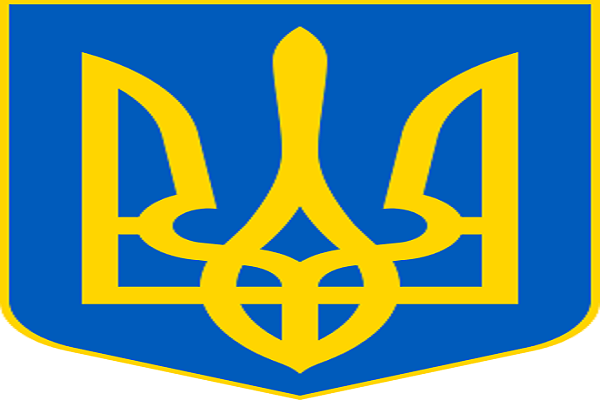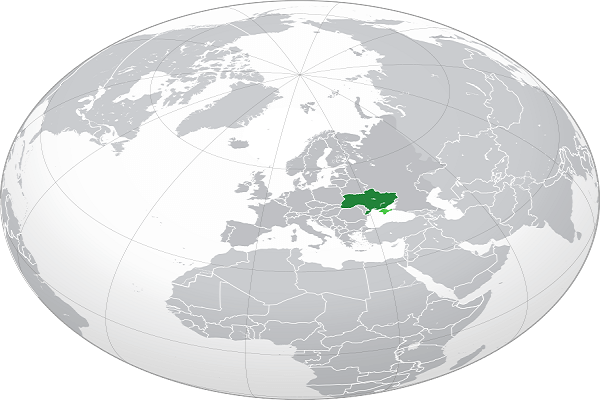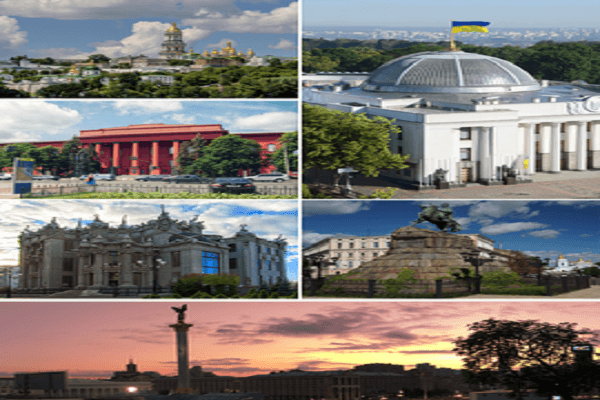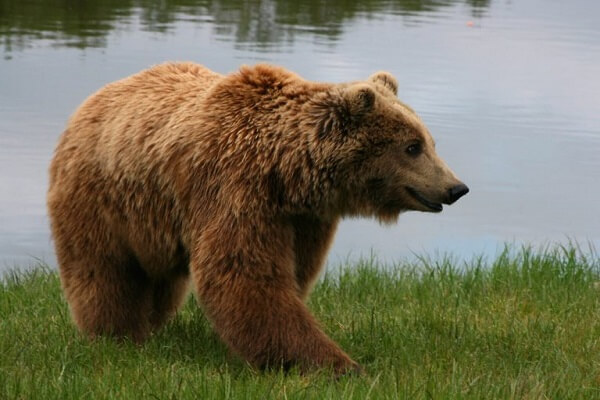

Ukraine is a country in Eastern Europe. Its capital and largest city is Kiev. Ukrainian is the official language and its alphabet is Cyrillic. The dominant religions in the country are Eastern Orthodoxy and Greek Catholicism. Ukraine is currently in a territorial dispute with Russia over the Crimean Peninsula, which Russia annexed in 2014. The territory of modern Ukraine has been inhabited since 32,000 BC. During the Middle Ages, the area was a key centre of East Slavic culture, with the powerful state of Kievan Rus' forming the basis of Ukrainian identity. Following its fragmentation in the 13th century, the territory was contested, ruled and divided by a variety of powers, including Lithuania, Poland, Austria-Hungary, the Ottoman Empire and Russia. A Cossack republic emerged and prospered during the 17th and 18th centuries, but its territory was eventually split between Poland and the Russian Empire, and finally merged fully into the Russian-dominated Soviet Union in the late 1940s as the Ukrainian Soviet Socialist Republic. In 1991 Ukraine gained its independence from the Soviet Union in the aftermath of its dissolution at the end of the Cold War. The country is home to a multi-ethnic population, 77.8 percent of whom are Ukrainians, followed by a very large Russian minority, as well as Georgians, Romanians, Belarusians, Crimean Tatars, Jews, Bulgarians and Hungarians.


603,628 km2 (45th)

Kiev
Kiev is the capital and most populous city of Ukraine, located in the north-central part of the country on the Dnieper. Kiev is an important industrial, scientific, educational and cultural center of Eastern Europe. It is home to many high-tech industries, higher education institutions, and world-famous historical landmarks. The city has an extensive infrastructure and highly developed system of public transport, including the Kiev Metro. The city's name is said to derive from the name of Kyi, one of its four legendary founders. The city prospered again during the Russian Empire's Industrial Revolution in the late 19th century. In 1917, after the Ukrainian National Republic declared independence from the Russian Empire, Kiev became its capital. From 1921 onwards Kiev was a city of the Ukrainian Soviet Socialist Republic, which was proclaimed by the Red Army, and, from 1934, Kiev was its capital. During World War II, the city again suffered significant damage, but quickly recovered in the post-war years, remaining the third largest city of the Soviet Union. Following the collapse of the Soviet Union and Ukrainian independence in 1991, Kiev remained the capital of Ukraine and experienced a steady migration influx of ethnic Ukrainians from other regions of the country.

Ukrainian

'Liberty, concord, goodness'

Sunflower (Helianthus annuus)
Sunflower (Helianthus annuus) is a large annual forb of the genus Helianthus grown as a crop for its edible oil and edible fruits. This sunflower species is also used as wild bird food, as livestock forage (as a meal or a silage plant), in some industrial applications, and as an ornamental in domestic gardens. The name sunflower may derive from the flower's head's shape, which resembles the sun, or from the impression that the blooming plant appears to slowly turn its flower towards the sun as the latter moves across the sky on a daily basis. The plant has an erect rough-hairy stem, reaching typical heights of 3 metres (9.8 ft). The tallest sunflower on record achieved 9.17 metres (30.1 ft). Sunflower leaves are broad, coarsely toothed, rough and mostly alternate. What is often called the "flower" of the sunflower is actually a "flower head" or pseudanthium of numerous small individual five-petaled flowers ("florets"). The outer flowers, which resemble petals, are called ray flowers. Each "petal" consists of a ligule composed of fused petals of an asymmetrical ray flower. They are sexually sterile and may be yellow, red, orange, or other colors. The flowers in the center of the head are called disk flowers. These mature into fruit (sunflower "seeds"). The disk flowers are arranged spirally. Generally, each floret is oriented toward the next by approximately the golden angle, 137.5°, producing a pattern of interconnecting spirals, where the number of left spirals and the number of right spirals are successive Fibonacci numbers. Typically, there are 34 spirals in one direction and 55 in the other; however, in a very large sunflower head there could be 89 in one direction and 144 in the other. This pattern produces the most efficient packing of seeds mathematically possible within the flower head.

Bear (Ursus arctos)
Bear (Ursus arctos) is a bear that is found across much of northern Eurasia and North America. This species inhabits the broadest range of habitats of any living bear species. They seem to have no altitudinal preferences and have been recorded from sea level to an elevation of 5,000 m (16,000 ft). In most of their range, brown bears generally seems to prefer semi-open country, with a scattering of vegetation that can allow them a resting spot during the day. However, they have been recorded as inhabiting every variety of northern temperate forest known to occur.
Ukrainian
42,418,235
(2017 estimate)
Ukrainian hryvnia (UAH)
UTC+2 (EET)

*sources: Wikimedia Commons , google images